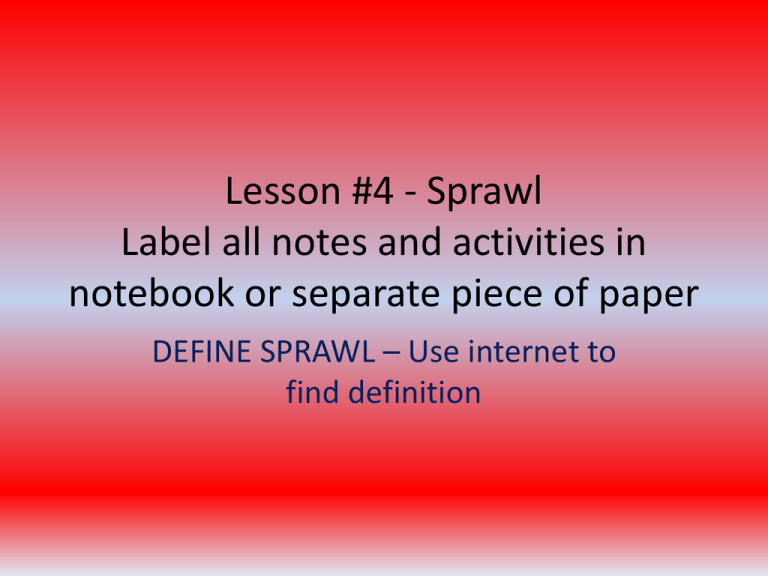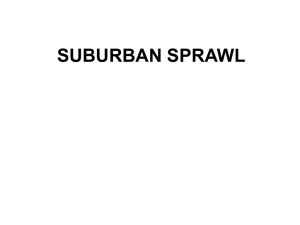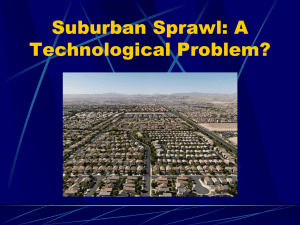Lesson #4
advertisement

Lesson #4 - Sprawl Label all notes and activities in notebook or separate piece of paper DEFINE SPRAWL – Use internet to find definition Lesson #4 - Sprawl • LEQ - How and why have American cities and suburbs changed with time? • Background - In the United States and around the world, places change constantly. It is true that changing physical conditions (sea level rise), depleted resources (played-out mine) or natural disasters (tornado or volcanic eruption) sometimes play a part, change more often results from immigration and an infusion of new cultural ideas, technological change, or economic factors. The final lesson of this unit looks at the effect the automobile has had on the American landscape. Opener – Complete in Notebook • In the United States, people who live in cities are less likely to own a car than people who live outside the city center. Why do you think this is so? Activity #1 • Go to Sprawling and Planned Communities PPT found in folder or on website – Take Notes – Copy and Answer all questions in Notebook – Answer all Think About It! Question on separate piece of paper Sprawl Notes • In class notes, Answer – – How does the place of the center city differ from the suburban areas connected to it? – Are the differences only in concentration (more people, more buildings, more smog, more crime in the center city than in the suburbs) or are there some features that are distinct to each place? • In vocabulary section – create working definition for “urban” and “suburban” Activity #2 • Pick the name of a major US city (NYC, Philadelphia, Los Angeles, etc.) • In notebook – – Use the internet, and create a list of the suburbs that are clustered outside the city. – What are the main road connections that link the suburb to the core city and to other suburbs? – Why do you think these suburbs were formed? Activity #3 • Class work – Read “How Urban Sprawl Works” – Reading in file or on website • Read pages 1-3 ONLY – Get copy of worksheet from teacher Activity #4 • “Sprawlanta” Video Link – Answer questions when finished on separate piece of paper • What were the push factors (negative factors they wished to leave behind)? • What were the pull factors (benefits Americans hoped to gain as they moved farther from the city center)? Activity #5 • Copy and Answer in notebook – – How did growing populations and the automobile, result in suburban sprawl? • Tracking Land use Changes Through Time PPT – Found in folder or on website – Answer question on separate piece of paper Activity #6 • Tackling Sprawl and Transportation Issues PPT – Found in folder or on website – Take notes in notebook – Answer Think About It! On separate piece of paper – In Notebook – • Identify disadvantages to individuals of living in the suburbs. • What disadvantages or issues rooted in suburban living have affected society as a whole? Activity #6 Checking for Understanding • Answer these questions based on what you have learned on separate piece of paper: – What are the main problems or issues planners are trying to solve as they apply their ideas to traditional sprawl development? – Will the new suburb make travel to the core city unnecessary? – Will the residents of the suburbs drive fewer total miles under the new development schemes? Activity #7 • Compare and evaluate two communities based on their planned street patterns • Transportation in Europe PPT – Found in folder or on website – Take notes in notebook – Answer in notebook • How would increased use of mass transit affect life in American suburbs and urban centers? Activity #7 – Checking for Understanding • Answer on separate piece of paper – In the 1890’s bicycles were very popular in the US, but today Europeans appear to be more open to bicycle transportation than Americans. Based on what you have learned, what geographic factors may explain this change in transportation choices? Homework • Study for Unit 3 test







